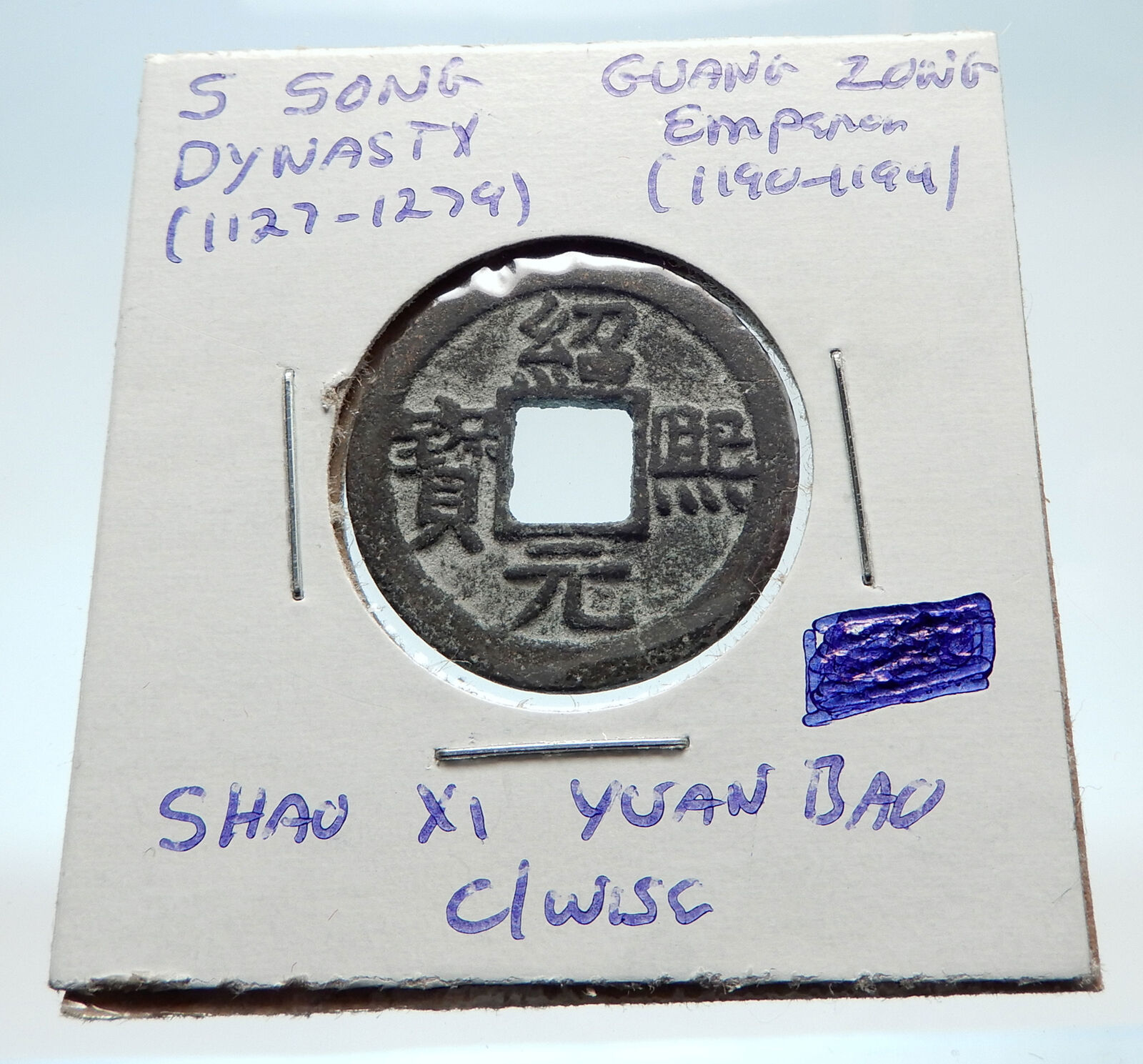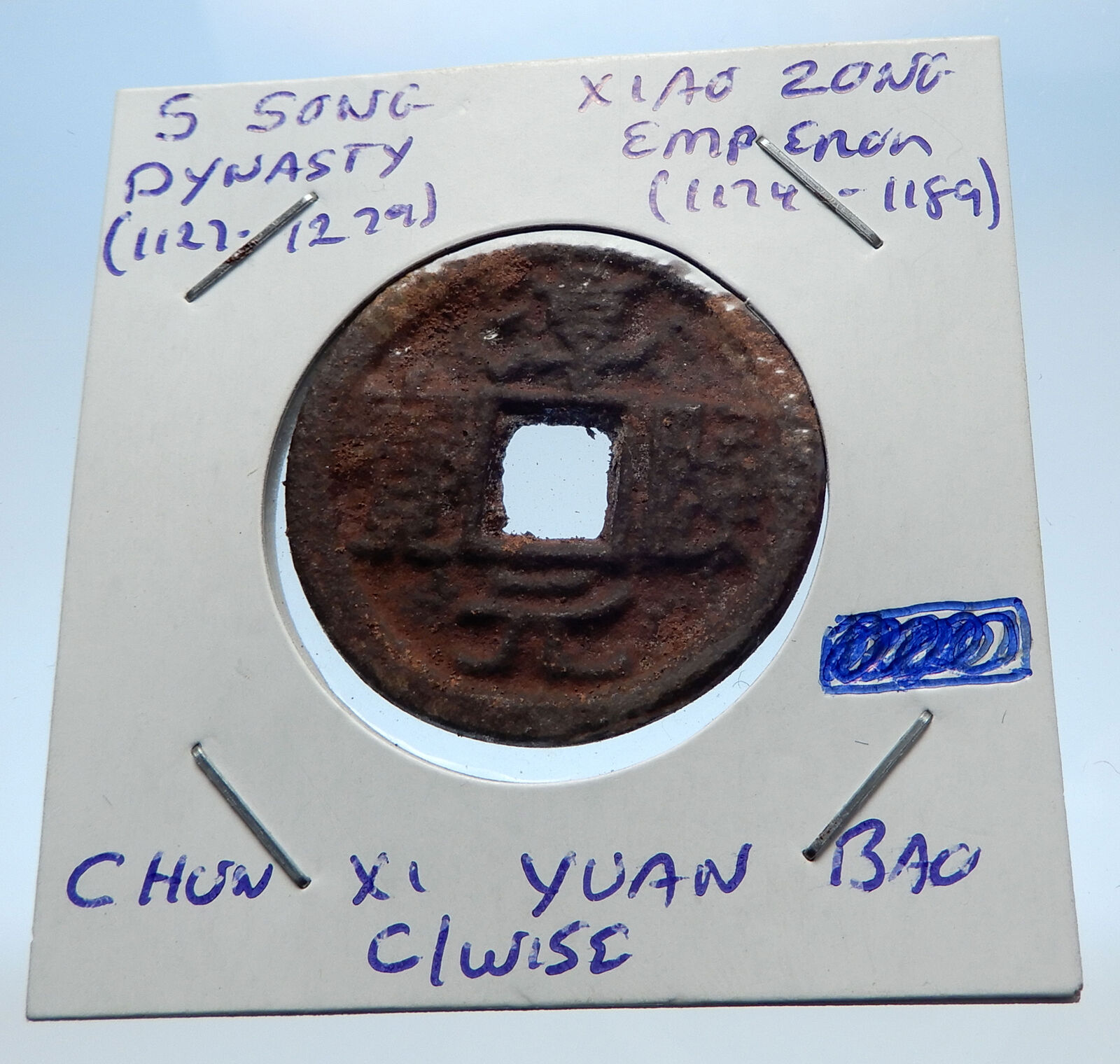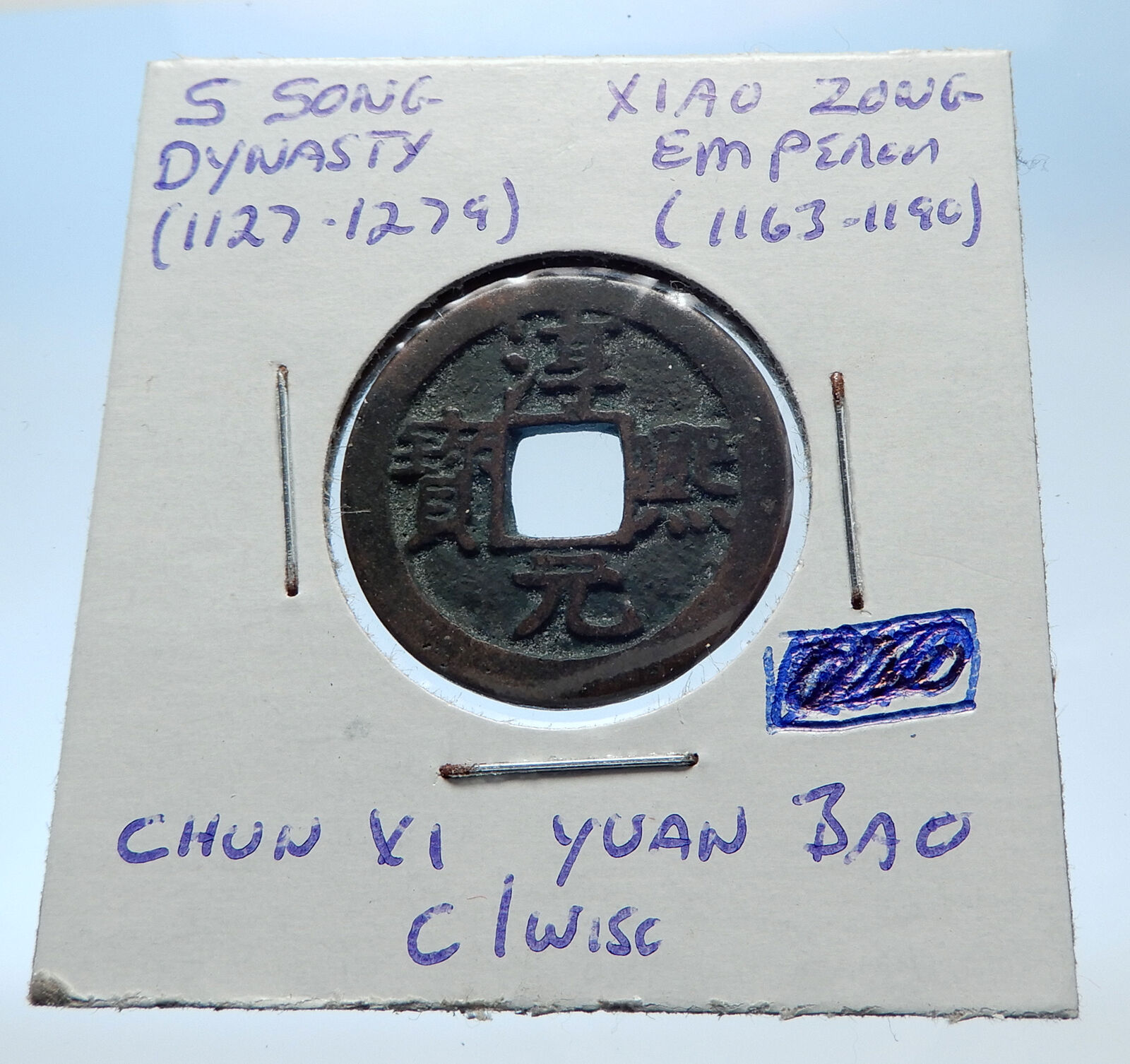|
China – Southern Ming Dynasty (1644-1682 A.D.)
Ming Rebel (Ming-Qing Transition)
Wu Sangui – Ruled: 1674-1678 A.D.
Bronze Cash 24mm
You are bidding on the exact item pictured, provided with a Certificate of Authenticity and Lifetime Guarantee of Authenticity.
Cash was a type of coin of China and East Asia, used from the 4th century BC until the 20th century AD. Originally cast during the Warring States period, these coins continued to be used for the entirety of Imperial China as well as under Mongol, and Manchu rule. The last Chinese cash coins were cast in the first year of the Republic of China. Generally most cash coins were made from copper or bronze alloys, with iron, lead, and zinc coins occasionally used less often throughout Chinese history. Rare silver and gold cash coins were also produced. During most of their production, cash coins were cast but, during the late Qing dynasty, machine-struck cash coins began to be made. As the cash coins produced over Chinese history were similar, thousand year old cash coins produced during the Northern Song dynasty continued to circulate as valid currency well into the early twentieth century.
In the modern era, these coins are considered to be Chinese “good luck coins”; they are hung on strings and round the necks of children, or over the beds of sick people. They hold a place in various superstitions, as well as Traditional Chinese medicine, and Feng shui. Currencies based on the Chinese cash coins include the Japanese mon, Korean mun, Ryukyuan mon, and Vietnamese văn.
 Wu Sangui (Chinese: 吳三桂; pinyin: Wú Sānguì; Wade-Giles: Wu San-kuei; courtesy name Changbai (長白) or Changbo (長伯); 1612 – 2 October 1678) was a Chinese military general who was instrumental in the fall of the Ming dynasty and the establishment of the Qing dynasty in 1644. He is considered by traditional scholars as a traitor to both the Ming and the Qing dynasty. In 1678, Wu declared himself the Emperor of China and the ruler of the “Great Zhou”. However, his revolt was eventually quelled by the Kangxi Emperor of the Qing Dynasty. Wu Sangui (Chinese: 吳三桂; pinyin: Wú Sānguì; Wade-Giles: Wu San-kuei; courtesy name Changbai (長白) or Changbo (長伯); 1612 – 2 October 1678) was a Chinese military general who was instrumental in the fall of the Ming dynasty and the establishment of the Qing dynasty in 1644. He is considered by traditional scholars as a traitor to both the Ming and the Qing dynasty. In 1678, Wu declared himself the Emperor of China and the ruler of the “Great Zhou”. However, his revolt was eventually quelled by the Kangxi Emperor of the Qing Dynasty.
In popular culture
In contemporary China, Wu has often been regarded as a traitor and an opportunist, due to his betrayal of both the Ming and Qing dynasties. However, more sympathetic characterizations are sometimes voiced, and it is clear that Wu’s romance with and love for his concubine, Chen Yuanyuan, remains one of the classic love stories in Chinese history.
Wu’s early life and military career are portrayed in a more positive light in the CCTV television series The Affaire in the Swing Age, in which he is shown to be forced into making the fateful decisions which have made him famous.
Wuxia writer Louis Cha’s novel The Deer and the Cauldron portrays Wu as a powerful nemesis to the Kangxi Emperor, who sends the protagonist of the novel, Wei Xiaobao, to scout out Wu’s forces in Yunnan.
The Southern Ming was a loyalist rump state that existed in southern China following the Ming dynasty’s collapse in 1644. The Ming were overthrown when peasant rebels captured Beijing. Ming general Wu Sangui then opened the gates of the Great Wall to the nomadic Manchu horde, in hope of using them to annihilate rebel force. Loyalists fled to Nanjing, where they enthroned the Zhu Yousong, Prince of Fu. The Nanjing regime lasted until 1645, when the Qing captured Nanjing. Later, a series of pretenders held court in various southern Chinese cities.
The Nanjing regime lacked the resources to pay and supply its soldiers, who were left to live off the land and pillaged the countryside. The soldiers’ behavior was so notorious that they were refused entry by those cities in a position to do so. Court official Shi Kefa obtained modern cannons and organized resistance at Yangzhou. The cannons mowed down a large number of Qing soldiers, but this only enraged those who survived. After the Yangzhou city fell in May 1645, the Qing slaughtered as many as 800,000 inhabitants in a notorious massacre. Nanjing captured promptly by Qing on June 6 and the Prince of Fu was taken to Beijing and executed in 1646.
The literati in the provinces responded to the news from Yangzhou and Nanjing with an outpouring of emotion. Some recruited their own militia and became resistance leaders. Shi was lionized and there was a wave of hopeless sacrifice by loyalists who vowed to erase the shame of Nanjing. By late 1646, the heroics had petered out and the Qing advance had resumed. Notable Ming pretenders held court in Fuzhou (1645-1646), Guangzhou (1646-1647), and Anlong (1652-1659). The Prince of Ningjing maintained a palace in the Kingdom of Tungning (based in modern-day Tainan, Taiwan) until 1683.
The end of the Ming and the subsequent Nanjing regime are depicted in Peach Blossom Fan, a classic of Chinese literature. The upheaval of this period, sometimes referred to as the Ming-Qing cataclysm, has been linked to a decline in global temperature known as the Little Ice Age. With agriculture devastated by a severe drought, there was manpower available for numerous rebel armies.

The transition from Ming to Qing or the Ming-Qing transition, also known as the Manchu conquest of China, was a decades-long period of conflict between the Qing dynasty, established by Manchu clan Aisin Gioro in Manchuria (contemporary Northeastern China), and the Ming dynasty of China in the south (various other regional or temporary powers were also associated with events, such as the short-lived Shun dynasty). Leading up to the Qing conquest, in 1618, Aisin Gioro leader Nurhaci commissioned a document entitled the Seven Grievances, which enumerated grievances against the Ming and began to rebel against their domination. Many of the grievances dealt with conflicts against Yehe, which was a major Manchu clan, and Ming favoritism of Yehe. Nurhaci’s demand that the Ming pay tribute to him to redress the seven grievances was effectively a declaration of war, as the Ming were not willing to pay money to a former tributary. Shortly afterwards, Nurhaci began to rebel against the Ming in Liaoning in southern Manchuria.
At the same time, the Ming dynasty was fighting for its survival against fiscal turmoil and peasant rebellions. On April 24, 1644, Beijing fell to a rebel army led by Li Zicheng, a former minor Ming official who became the leader of the peasant revolt, who then proclaimed the Shun dynasty. The last Ming emperor, the Chongzhen Emperor, hanged himself from a tree in the imperial garden outside the Forbidden City. When Li Zicheng moved against him, the Ming general Wu Sangui shifted his alliance to the Manchus. Li Zicheng was defeated at the Battle of Shanhai Pass by the joint forces of Wu Sangui and Manchu prince Dorgon. On June 6, the Manchus and Wu entered the capital and proclaimed the young Shunzhi Emperor as Emperor of China.
The conquest was far from complete however, and it required almost forty more years before all of a China was securely united under Qing rule. The Kangxi Emperor ascended the throne in 1661, and in 1662 his regents launched the Great Clearance to defeat the resistance of Ming loyalists in South China. He then fought off several rebellions, such as the Revolt of the Three Feudatories led by Wu Sangui in southern China, starting in 1673, and then countered by launching a series of campaigns that expanded his empire. In 1662, Zheng Chenggong (Koxinga) drove out the Dutch colonists and founded the Kingdom of Tungning in Taiwan, a Ming loyalist state with a goal of reconquering China. However, Tungning was defeated in 1683 at the Battle of Penghu by Han admiral Shi Lang, a former admiral under Koxinga.
The fall of the Ming dynasty was largely caused by a combination of factors. Kenneth Swope argues that one key factor was deteriorating relations between Ming Royalty and the Ming Empire’s military leadership. Other factors include repeated military expeditions to the North, inflationary pressures caused by spending too much from the imperial treasury, natural disasters and epidemics of disease. Contributing further to the chaos was a peasant rebellion in Beijing in 1644 and a series of weak emperors. Ming power would hold out in what is now southern China for years, though eventually would be overtaken by the Manchus.
|





 Wu Sangui (Chinese: 吳三桂; pinyin: Wú Sānguì; Wade-Giles: Wu San-kuei; courtesy name Changbai (長白) or Changbo (長伯); 1612 – 2 October 1678) was a Chinese military general who was instrumental in the fall of the Ming dynasty and the establishment of the Qing dynasty in 1644. He is considered by traditional scholars as a traitor to both the Ming and the Qing dynasty. In 1678, Wu declared himself the Emperor of China and the ruler of the “Great Zhou”. However, his revolt was eventually quelled by the Kangxi Emperor of the Qing Dynasty.
Wu Sangui (Chinese: 吳三桂; pinyin: Wú Sānguì; Wade-Giles: Wu San-kuei; courtesy name Changbai (長白) or Changbo (長伯); 1612 – 2 October 1678) was a Chinese military general who was instrumental in the fall of the Ming dynasty and the establishment of the Qing dynasty in 1644. He is considered by traditional scholars as a traitor to both the Ming and the Qing dynasty. In 1678, Wu declared himself the Emperor of China and the ruler of the “Great Zhou”. However, his revolt was eventually quelled by the Kangxi Emperor of the Qing Dynasty. 





